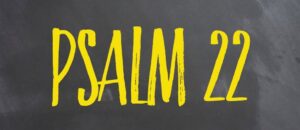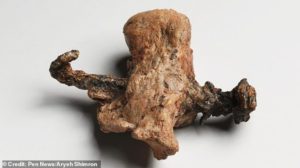Psalms 22 – a Catch 22 Crucifixion Prophecy
 Psalms 22 is retrospectively viewed by Christians as a foreshadowing or a prophecy consistent with Isaiah’s and Zechariah’s Messiah prophecies. Some say it is neither, rather a falsehood.[1]
Psalms 22 is retrospectively viewed by Christians as a foreshadowing or a prophecy consistent with Isaiah’s and Zechariah’s Messiah prophecies. Some say it is neither, rather a falsehood.[1]
Prophecies are challenging due to many factors and, in some cases, it may be clarified by other prophecies.[2] Typically not straightforward nor easy to understand, a prophecy is often not fully or clearly understood until a full realization that the foretold event did, in fact, occur.
To have prophetic qualities, Psalm 22 would need to predict details about a crucifixion that are precise enough to avoid conjecture. Written at a time when the Roman Empire did not yet exist, the Psalm’s content appears even more prophetic because the Roman-style crucifixion had not yet been devised.
“I am poured out like water, and all my bones are out of joint. My heart has turned to wax; it has melted away within me. My strength is dried up like a potsherd, and my tongue sticks to the roof of my mouth; you lay me in the dust of death. Dogs have surrounded me; a band of evil men has encircled me, they have pierced my hands and my feet. I can count all my bones; people stare and gloat over me.”[3]
Not quoted by a crucifixion victim known by Jewish historian Josephus nor is it a quote from any other Roman historians who documented Roman crucifixions. The description was written by King David in Psalms 22 centuries earlier, yet the depiction is wholly consistent with that of a Roman crucifixion victim.
Rabbi sages do not consider the Psalms as a book of prophecy although renowned Jewish sage Rabbi Rashi twice identified Psalms 22 verses as having futuristic implications involving David and the Messiah. Rashi commented, “David recited this prayer for the future” and later for verse 27, he commented “The humble shall eat” meaning “at the time of our redemption in the days of our Messiah.”[4]
Josephus described an occasion where he was traveling with the Roman military when they came upon three of his Jewish acquaintances among many others being crucified along the road to Thecoa, not far from Bethlehem.[5] Struck with compassion, he pleaded personally to Titus Caesar to have mercy who then commanded the victims to be taken down from their crosses and treated by Roman physicians, but still only one survived.
Inflicted extreme suffering, specific actions, and spoken words in Psalms 22 are remarkably similar to the Gospel accounts of the crucifixion of Jesus of Nazareth. Eyewitness John’s Gospel account says it succinctly:
JN19:17-18 “Carrying his own cross, he went out to the place of the Skull (which in Aramaic is called Golgotha).” Here they crucified him, and with him two others—one on each side and Jesus in the middle.
Raising the bar for prophetic difficulty are very distinct actions from Psalms 22 – quotes and explicit activities by persons other than the victim. Such activities could not be replicated by the single victim though both occurred, according to Gospel accounts:
PS 22:7-8 All who see me mock me; they hurl insults, shaking their heads: “He trusts in the LORD; let the LORD rescue him. Let him deliver him, since he delights in him.”(NIV)
LK 23:35-36 “The people stood watching, and the rulers even sneered at him. They said, “He saved others; let him save himself if he is the Christ of God, the Chosen One. The soldiers also came up and mocked him.” (NIV)
PS 22:18 “They divide my clothes among themselves and throw dice for my garments.”(NIV)
MK15:24 “And they crucified him. Dividing up his clothes, they cast lots to see what each would get.”(NIV)
A quote, “My God, my God, why have you forsaken me?” opens Psalms 22 in the first verse. These words were uttered by Jesus when he was in agony dying on the cross:
Ps 22:1 “My God, my God, why have you forsaken me?” (NIV)
MT 27:45-46, MK 15:33-34 “Now from the sixth hour until the ninth hour there was darkness over all the land. And about the ninth hour Jesus cried out with a loud voice, saying, ‘Eli, Eli, lama sabachthani?” that is, “My God, My God, why have You forsaken Me?’”(NIV)
By the time Jesus moaned these words, he had already endured severe flogging, exposed raw flesh, severe blood loss, acute dehydration, exposure to the weather, hanging by nails from the cross, labored and painful breathing and in state of shock. In his excruciating misery and naked humiliation, he would have seen and heard the gawking and sneering crowd with their taunts and insults.
For Psalms 22 to be prophetic, Jesus would have to know this in advance – before his arrest, trial, and crucifixion with the most unlikely collusion between the Jews and their hated Roman enemies – and there would a moment to quote these words from the cross. It would take supernatural, advance knowledge of this scenario.
If Jesus was a fraud, it would have been fully dependent upon Psalms 22 being prophetic or else a false Messiah could not sell the fraud. Said another way, Psalms 22 had to be prophetic in order to advance a false Messiah narrative; otherwise quoting from the Psalm would be no more than a series of pointless coincidences.
Catch 22
What are the odds that Psalms 22 is a Messiah prophecy that was fulfilled by the crucifixion of Jesus?
Updated October 15, 2025.
This work is licensed under a Creative Commons Attribution-NonCommercial-NoDerivatives 4.0 International License.
REFERENCES:
[1] Green, James. Psalm 22: Is it a Prophecy about Christ?” CultoftheLivingGod. n.d.<http://www.cultofthelivinggod.net/islam/Psalm%2022%20-Prophecy%20about%20Christ.htm> Berkovitz, Abraham J. The Torah. ““My God, My God, Why Have You Forsaken Me?” — Jesus or Esther?” 2022. <https://www.thetorah.com/article/my-god-my-god-why-have-you-forsaken-me-jesus-or-esther>
[2] Bugg, Michael. “Types of Prophecy and Prophetic Types.” Hebrew Root. n.d. <http://www.hebrewroot.com/Articles/prophetic_types.htm> Brooks, Carol. “Prophecy.” InPlainSite.org. <http://www.inplainsite.org/html/old_testament_prophecy.html> “Plaster Miodu. Psalm 22: Na krańce ciemności.” (translated: “Honeycomb. Psalm 22: To the ends of darkness.”) YouTube. image. 2015. <https://i.ytimg.com/vi/rUjYzzjEHfw/maxresdefault.jpg>
[3] Psalms 22:14-17. NIV.
[4] The Complete Jewish Bible – with Rashi Commentary. Online English translation of the Tanakh (Jewish Bible) with Rashi’s commentary. n.d. <https://www.chabad.org/library/bible_cdo/aid/16243/showrashi/true
[5] Josephus, Flavius. The Life of Flavius Josephus. #75. The Complete Works of Josephus. 1850. http://books.google.com/books?id=e0dAAAAAMAAJ&printsec=frontcover&source=gbs_ge_summary_r&cad=0#v=onepage&q&f=false> “Thecoa.” Bible History Online. 2017. <http://www.bible-history.com/geography/ancient-israel/thecoa.html>


